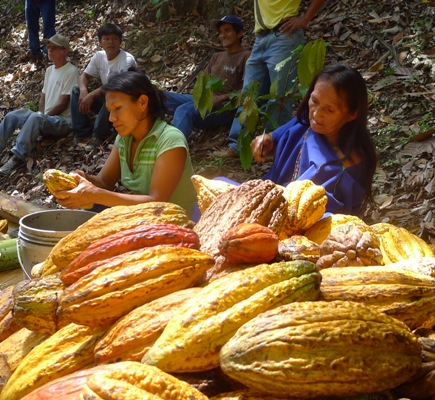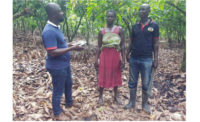
|
|
Women from San Juan de Cheni remove cocoa beans from pods growing in the village. Photo provided by Hershey. |
Back in 2008, The Hershey Co. was introduced to a village of indigenous people tucked deep in the mountains of the Junín region of Peru.
This village — San Juan de Cheni — had been devastated by years of guerilla warfare, and was attempting to rebuild with cocoa farming. The community chose cocoa as its primary crop hoping to help restore its economy, position it for the future and preserve the traditional values of farming embedded in the culture.
Hershey decided to support the community, and committed to help fund the infrastructure needed for the village to be successful in cocoa farming. The chocolate maker also committed to buying cocoa grown in this area.
San Juan de Cheni grows a unique variety of cocoa with a distinct flavor, and Hershey uses the village’s cocoa in its high-end artisan chocolate products.
“From the day we learned of San Juan de Cheni, we knew this village was something special,” says Ray Major, senior manager of sustainability initiatives. “The people in this community are intensely driven to rebuild their community through cocoa farming and it has been rewarding to watch the village improve its fortunes with a little help and support.”
Prior to Hershey’s support, San Juan de Cheni cocoa farms had approximately 500 trees per hectare and cocoa farming had been negatively impacted by guerilla activity in the late 1980s and early 1990s.
Hershey’s goal in supporting San Juan de Cheni was to more than double the amount of trees per hectare producing cocoa.
Starting in 2010, Hershey, its sourcing partners and the community farmers focused on increasing the number of trees that produced the best quality and highest quantity of cocoa pods.
With Hershey’s support, the community built a nursery to increase tree stock and Hershey funded the training and tools needed to improve the productivity of the cocoa farms.
The training included grafting methods to populate the farms using the community’s best trees. Today, more than 50 farms have more than 1,100 thriving cocoa trees per hectare, while tree stock and yields continue to improve.
During the second year of the project, Hershey aided in building a fermentation center to enable the village to produce higher-quality cocoa as well as a septic system to control waste. Hershey also helped fund the construction of a cocoa warehouse and a community computer center, which now serves as the village’s first public meeting facility.
After more than two years of investments by The Hershey Co., San Juan de Cheni has rebuilt its community, stabilized village life and established a successful cocoa economy through the sale of its premium cocoa.
“Today we see how this relatively small investment has made a big difference in the lives of everyone in this community. It’s great to see how the community’s hard work has paid off,” Major says.
Hershey has implemented the San Juan de Cheni initiative with the help of its sourcing partners Romex and Mitsubishi.
Romex, one of the largest agricultural trading companies in Peru, has helped supply agricultural extension services, technical support, materials for the fermentation equipment, farm equipment and agricultural inputs. Mitsubishi helps with project implementation and oversees exporting the village’s cocoa beans from Peru to the United States.
Purchasing sustainably grown cocoa sourced from the village of San Juan de Cheni is one of many ways Hershey positively supports cocoa communities around the world. This initiative is part of Hershey’s 21stCentury Cocoa Sustainability Strategy, a comprehensive plan to improve the livelihoods of cocoa farmers and communities that depend on cocoa. The cocoa grown in San Juan de Cheni is third-party certified and contributes to the company’s commitment to source 100-percent certified cocoa in all of its products by 2020.



